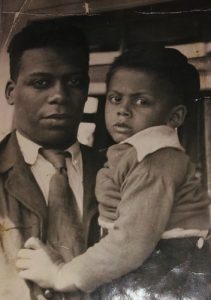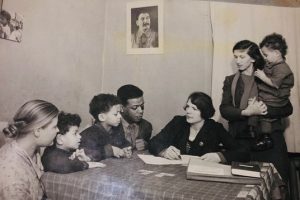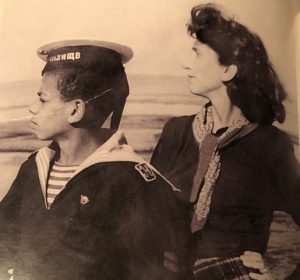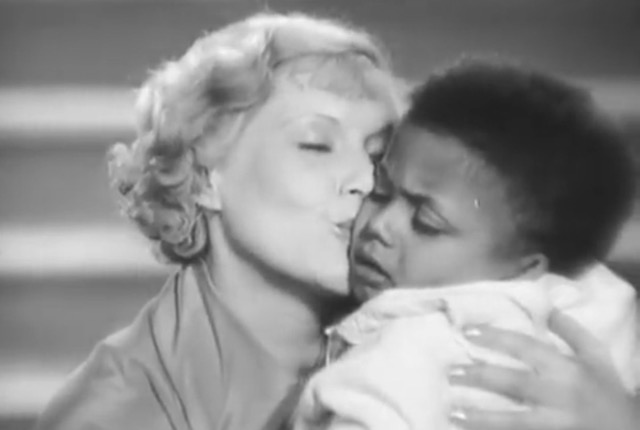In the following article, Amy Ballard, Senior Historic Preservation Specialist Emerita, Smithsonian Institution, describes the life of Russian-born James Lloydovich Patterson, who, at the age of three, was propelled to stardom in the 1936 Soviet classic film TSIRK (Circus). It was, in its own way, a critique of racial discrimination in the United States and other capitalist nations. It also pays homage to the famed Russian circus. Ballard explores the life of Patterson in the Soviet Union and the United States, after 1995. She met Patterson in 2020 and they became fast friends.
At age 91, James Lloydovich Patterson lives a quiet life in Washington, DC. His apartment walls are filled with photos of his family, friends, certificates, and letters of recognition. Of his life today, he says, “I have all I need.” And what a life, indeed, he can reflect upon.
We begin this incredible story of his life with his father Lloyd Walton Patterson. In 1910, Lloyd Patterson was born in New York City. He was the only child of Archie and Margaret Patterson. Margaret’s parents were enslaved in Virginia and, after the Civil War worked as sharecroppers. Archie died just three months after Lloyd was born. Margaret, now a widow, made a living for herself and was able to see Lloyd off to Hampton Institute in Virginia to study design. After graduating, he found that he couldn’t use his talent as the only jobs offered to him were painting fences and cutting grass. He wanted a better life.
Lloyd saw a newspaper article about the Co-Operating Committee for Production of a Soviet Film on Negro Life asking for volunteers to travel to the Soviet Union in June 1932 to make the film. Louise Thompson, the American representative for the project, accepted his application, perhaps due to his artistic background. Lloyd left for Moscow on June 15, 1932, along with twenty-one Black Americans, including Langston Hughes, Dorothy West, and Wayland Rudd.
The “Black and White” film project fell through soon after the arrival of the African Americans. Most of them returned home, but Lloyd met Ukrainian-born set designer and artist Vera Aralova. They married and had three children: James, Lloyd Junior, and Tom. James, born in 1933, remembers, “Father wanted us to have American names and not Russian, so he could pronounce them!”
Lloyd had no trouble finding work that he loved in the Soviet Union. He and Vera worked on theatre designs and Lloyd was asked to design and paint stencils in the new wing of the renowned Metropol Hotel in Moscow. Eventually, Lloyd became a radio broadcaster in English for Radio Moscow.
The Pattersons had a rich family life in the Soviet Union. When they weren’t in their Moscow apartment, they spent time at their dacha in the countryside. Lloyd was a brilliant pianist who had become friends with Paul Robeson who visited the family when the legendary civil rights activist was in Moscow.
Young James inherited his father’s love of music and attended the Gnessin School of Music, where he studied the cello. Vera’s mother, Vera Grigorieva Aralova, lived with them, and in 1937, Grandmother Margaret visited them from the United States. While there, she briefly worked in a Soviet factory.
James and his brothers were great friends. Lloyd Junior, born in 1935, was the most artistic of the siblings, often working with his mother in design. He died in a car crash in Moscow in 1960. Born in 1937, Tom, the youngest, was intrigued by technology and became a Soviet army pilot and later a television cameraman in Moscow. He died in July 2023 from a heart attack at age 86.

Lloyd Patterson with James, ca. 1937 (Courtesy of James L. Patterson)
The Patterson apartment in Moscow was often full of other international visitors besides Robeson. Louise Thompson, Frances Williams, and Langston Hughes visited while in Moscow. The Pattersons also entertained important Russian cultural figures of the day, including writer (and one of Vera’s close friends) Lilya Brik, director and actor Vsevolod Meyerhold, and his wife, Zinaida Reich.
In 1936 director Grigori Aleksandrov and his wife, actress Lyubov Orlova, selected three-year-old James to appear in film TSIRK (Circus). Viewers took to heart his engaging performance and the story of his character “Jimmy.”
The story begins in the United States, where the main character is Marion Dixon, a circus performer played by Orlova. A mob discovers that she has a Black child. Terrified, she runs from the mob clutching her child and manages to board a train where her manager, Kneishitz, waits for her.
They decide to go to Russia, known for having the greatest circuses in the world. Her manager easily finds her work, and she becomes the star of the show. She falls in love with Martynov, another performer. Kneishitz, jealous with rage, tries to ruin her career by showing the audience Marion’s Black child, Jimmy. Calling the child every slur, he is stunned by the audience’s acceptance of the child. Little Jimmy is taken into the arms of the audience, being passed from person to person of every Russian ethnic group, singing lullabies to him in their own language. Kneishitz is told that in the Soviet Union, people of every color are welcome, and he slinks away in disbelief. The final scene of Circus shows Marion, Martynov, and little Jimmy marching in Red Square to a new life of promise and equality.

The Patterson Family at a Census Bureau in Moscow, ca. 1940 (Courtesy of James L. Patterson)
James’s role as the endearing biracial child in CIRCUS made him the biggest child star in Russia, as popular as Shirley Temple was in the United States. His friendships with the cast and crew continued throughout his life. He was particularly close to Lyubov Orlova, who he referred to, and still does, as his “movie mother,” and director Grigori Aleksandrov.
Today, James is the only CIRCUS cast member still alive from his only film. The possibility of a sequel surfaced in the 1960s, but it never came to fruition. He is still remembered with great fondness in Russia today.
When the Soviet Union entered World War II in 1941 after Nazi Germany invaded the nation, famous artists, including musicians, poets, composers, and actors, were evacuated to towns and cities far from Moscow. This directive included the Patterson family. Vera, her mother, and the boys were evacuated from Moscow to Sverdlovsk (now Yekaterinburg). Lloyd remained in Moscow until his Moscow radio building was bombed. In early 1942, Lloyd was transferred to Komsomolsk on the Amur River in the Russian Far East in order to broadcast radio programs in English directed at the United States. On the way, he stopped in Sverdlovsk to see his family. Soon after Lloyd arrived in Komsomolsk, he died of a concussion he had earlier received during a Nazi bombing raid on Moscow in March 1942.
Now a single mother, Vera, and the boys returned to Moscow when the war ended. After Lloyd’s death, Vera continued painting and worked at the House of Fashion in Moscow, eventually becoming its head. She was responsible for inventing the zippers on Russian women’s boots. She won numerous awards throughout her career while supporting and encouraging younger artists and models. Her paintings and designs are in many museums, including Abramtsevo and the Moscow Design Museum.
Young James had always expressed a love of the sea, and his mother enrolled him in the Nahkimov Naval Cadet School in Riga, Latvia (then part of the Soviet Union). Upon his graduation in 1951, he attended the Order of Lenin K.E. Voroshilov Naval Academy in Leningrad. His navy career was spent as an officer on Soviet submarines. In one instance, when he was the officer on duty temporarily commanding his submarine, he was responsible for making sure another approaching ship avoided striking his vessel in the fog. He later remembers the submarine commander commending him for his quick action with the often-repeated words, “Patterson saved the ship.”

Vera Aralova (James’s Mother) Visits Him at the Nakhimov Naval Academy, Riga (Courtesy of James L. Patterson)
After his naval service ended in 1957, James Patterson finally could pursue his lifelong love of poetry. He studied at the Maxim Gorky Literary Institute in Moscow, graduating in 1964. While at the institute, he heard and met many famous poets, such as Anna Akhmatova and Yevgeny Yevtushenko.
During his writing career, Patterson traveled throughout Russia to read his poems and, in the process, developed many fans across the Soviet Union. Patterson had a special affinity for Alexander Pushkin, Russia’s most beloved poet because both had a mixed-race heritage. His fans likewise often compared Patterson to Pushkin, who descended from Gannibal, a young Black African who was adopted by Peter the Great in 1705.
James Patterson’s first book, Chronicle of the Left Hand, published in the Soviet Union in 1964, combines the memoirs of his paternal grandmother, Margaret, the daughter of a Virginia sharecropper, with commentary and several poems by James. In 2022, an English-language edition was published for the first time in the United States. This edition contains footnotes, photographs from James’s personal collection, and contributions by scholars Allison Blakely, Rimgaila Salys, and Anna Lawton.

James Patterson With Wynton Marsalis, 2023 (Courtesy of James L. Patterson)
With the collapse of the Soviet Union in 1991, James and Vera found it difficult to make a living in Moscow. In 1995, James, now 62, and his mother, Vera, moved to Washington, DC. He chose to leave the land of his birth to “shape his destiny” in America and master the English language. He also wanted to see with his mother all the places his father had lived so they could get a better idea of the life he and Grandmother Margaret had lived in the United States.
Patterson arranged art shows for his mother and read his poetry to earn money. His younger brother, Tom, who remained in Russia, came to visit James and Vera in Washington in 1998. Vera died in 2001, and James subsequently became reclusive. He later developed a series of health problems, including a stroke he suffered in 2014. Today, 91-year-old James Patterson, former 1930s child star, lives quietly in a Washington, DC, apartment building for seniors where he receives care.
“Of course, I miss Russia all the time. I always missed Russia. I transitioned into a different atmosphere. There was a lot of transformation for me. I was looking for the future.”
He uses a wheelchair now and, with the help of his caregivers and friends, goes for outings to the Kennedy Center, poetry readings, and museums in Washington. “Time has passed, years have gone by, but I’m still the same little child from the movie Circus.


